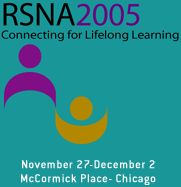
Abstract Archives of the RSNA, 2005
Isabel Pelaez MD, Abstract Co-Author: Nothing to Disclose
Salvador Pedraza MD, Presenter: Nothing to Disclose
Gema Laguillo, Abstract Co-Author: Nothing to Disclose
Josep Puig, Abstract Co-Author: Nothing to Disclose
Elena Asparren RN, Abstract Co-Author: Nothing to Disclose
Joan Baņos, Abstract Co-Author: Nothing to Disclose
Jose Mendez MD, Abstract Co-Author: Nothing to Disclose
et al, Abstract Co-Author: Nothing to Disclose
Different magnetic resonance sequences such as T2-weighted sequences can estimate the grade of lumbar disk degeneration. However there are no studies about the utility of diffusion-weighted (DW) imaging in the analysis of lumbar degenerative disease.
Our aim was to correlate the value of diffusion-weighted (DW) sequences with other sequences in the study of lumbar degenerative disease
A prospective study of lumbar spine in 29 patients ( 145 discs) was performed. Mean age was 46 years. The study protocol included a sagital T1-weighted sequence, a sagital T2-weighted sequence, a sagital STIR-weighted sequence, a sagital DW sequence (b:0,500), an axial T1-weighted sequence and an axial T2-weighted sequence. We performed a qualitative and quantitative assessment of degenerative disease by three independent observers. In the qualitative study we considered three grades of degenerative disease. In the quantitative assessment we determined the apparent diffusion coefficient (ADC) values of lumbar discs. Data were analysed by using Kappa correlation statistics.
The study showed differences between the different sequences and it was difficult to establish the differences between grade I and grade II.
The DIF b:500 sequence, DIF b:0 and STIR demonstrated a lower proportion of degenerative disease (16.5%-17.25% an 26.2%) with respect T2 (62.7%). However, the sequences of diffusion showed artefact, mainly in DIF b:500 (18.6%). The concordance between the two observers was poor with T2 (Kappa 0.24-0.75), better with STIR (Kappa 0.45-0.71) and DIF b:500 (0.47-0.62) and much better with DIF b:0 (Kappa 0.58-1). An increase of the degenerative discal disease with respect to the age was appreciated.
Our preliminary results suggested that the T2 weighted sequences have a high sensitivity but a lower specificity. The diffusion sequences (DIF b:500, DIF b:0) and STIR detect better the disks with severe degenerative disease. DIF b:0 was a fast sequence with a high accuracy and concordance and a low proportion of artefacts. Our study support the use of diffusion in the assessment of lumbar degenerative disease.
Pelaez, I,
Pedraza, S,
Laguillo, G,
Puig, J,
Asparren, E,
Baņos, J,
Mendez, J,
et al, ,
Utility of Diffusion-weighted Sequence in the Study of Lumbar Degenerative Disease. Radiological Society of North America 2005 Scientific Assembly and Annual Meeting, November 27 - December 2, 2005 ,Chicago IL.
http://archive.rsna.org/2005/4420195.html

